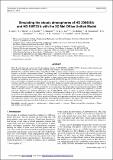Files in this item
Simulating the cloudy atmospheres of HD 209458 b and HD 189733 b with the 3D Met Office Unified Model
Item metadata
| dc.contributor.author | Lines, Stefan | |
| dc.contributor.author | Mayne, Nathan | |
| dc.contributor.author | Boutle, I. A. | |
| dc.contributor.author | Manners, J. | |
| dc.contributor.author | Lee, Graham Kim Huat | |
| dc.contributor.author | Helling, Christiane | |
| dc.contributor.author | Drummond, B. | |
| dc.contributor.author | Amundsen, D. S. | |
| dc.contributor.author | Goyal, J. | |
| dc.contributor.author | Acreman, D. M. | |
| dc.contributor.author | Tremblin, P. | |
| dc.contributor.author | Kerslake, M. | |
| dc.date.accessioned | 2018-06-07T08:30:07Z | |
| dc.date.available | 2018-06-07T08:30:07Z | |
| dc.date.issued | 2018-07 | |
| dc.identifier | 253290853 | |
| dc.identifier | c5953ef9-a045-4d06-9b57-dc04aa3fd8a0 | |
| dc.identifier | 85047192775 | |
| dc.identifier | 000439526600006 | |
| dc.identifier.citation | Lines , S , Mayne , N , Boutle , I A , Manners , J , Lee , G K H , Helling , C , Drummond , B , Amundsen , D S , Goyal , J , Acreman , D M , Tremblin , P & Kerslake , M 2018 , ' Simulating the cloudy atmospheres of HD 209458 b and HD 189733 b with the 3D Met Office Unified Model ' , Astronomy & Astrophysics , vol. 615 , A97 . https://doi.org/10.1051/0004-6361/201732278 | en |
| dc.identifier.issn | 0004-6361 | |
| dc.identifier.uri | https://hdl.handle.net/10023/13790 | |
| dc.description.abstract | Aims.To understand and compare the 3D atmospheric structure of HD 209458 b and HD 189733 b, focusing on the formation and distribution of cloud particles, as well as their feedback on the dynamics and thermal profile. Methods. We coupled the 3D Met Office Unified Model (UM), including detailed treatments of atmospheric radiative transfer anddynamics, to a kinetic cloud formation scheme. The resulting model self–consistently solves for the formation of condensation seeds,surface growth and evaporation, gravitational settling and advection, cloud radiative feedback via absorption, and crucially, scattering. We used fluxes directly obtained from the UM to produce synthetic spectral energy distributions and phase curves. Results. Our simulations show extensive cloud formation in both HD 209458 b and HD 189733 b. However, cooler temperatures in the latter result in higher cloud particle number densities. Large particles, reaching 1μm in diameter, can form due to high particle growth velocities, and sub-μm particles are suspended by vertical flows leading to extensive upper-atmosphere cloud cover. A combination of meridional advection and efficient cloud formation in cooler high latitude regions, results in enhanced cloud coverage for latitudes above 30° and leads to a zonally banded structure for all our simulations. The cloud bands extend around the entire planet, for HD209458 b and HD 189733 b, as the temperatures, even on the day side, remain below the condensation temperature of silicates and oxides. Therefore, the simulated optical phase curve for HD 209458 b shows no ‘offset’, in contrast to observations. Efficient scattering of stellar irradiation by cloud particles results in a local maximum cooling of up to 250 K in the upper atmosphere, and an advection-driven fluctuating cloud opacity causes temporal variability in the thermal emission. The inclusion of this fundamental cloud-atmosphere radiative feedback leads to significant differences with approaches neglecting these physical elements, which have been employed to interpret observations and determine thermal profiles for these planets. This suggests that readers should be cautious of interpretations neglecting such cloud feedback and scattering, and that the subject merits further study. | |
| dc.format.extent | 27 | |
| dc.format.extent | 8860672 | |
| dc.language.iso | eng | |
| dc.relation.ispartof | Astronomy & Astrophysics | en |
| dc.subject | Methods: numerical | en |
| dc.subject | Hydrodynamics | en |
| dc.subject | Radiative transfer | en |
| dc.subject | Scattering | en |
| dc.subject | Planets and satellites: atmospheres | en |
| dc.subject | Planets and satellites: gaseous planets | en |
| dc.subject | QB Astronomy | en |
| dc.subject | QC Physics | en |
| dc.subject | Space and Planetary Science | en |
| dc.subject | Astronomy and Astrophysics | en |
| dc.subject | NDAS | en |
| dc.subject.lcc | QB | en |
| dc.subject.lcc | QC | en |
| dc.title | Simulating the cloudy atmospheres of HD 209458 b and HD 189733 b with the 3D Met Office Unified Model | en |
| dc.type | Journal article | en |
| dc.contributor.institution | University of St Andrews. School of Physics and Astronomy | en |
| dc.contributor.institution | University of St Andrews. St Andrews Centre for Exoplanet Science | en |
| dc.identifier.doi | https://doi.org/10.1051/0004-6361/201732278 | |
| dc.description.status | Peer reviewed | en |
| dc.identifier.url | https://arxiv.org/abs/1803.00226 | en |
This item appears in the following Collection(s)
Items in the St Andrews Research Repository are protected by copyright, with all rights reserved, unless otherwise indicated.

